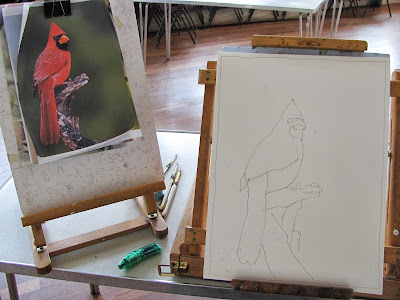It is often said that sound drawing is the basis of all good painting. I don't think many will dispute this and certainly my advice to anyone starting young would be to spend the first two years just learning to draw properly. Workshop teachers will tell you that one of the problems they have is that students - particularly those who have taken up painting late in life - want to start painting immediately without getting too involved in the basics. I have made sporadic attempts to improve my drawing and it is certainly better. One of my problems is that I don't have the steadiest of hands, a reason why I was attracted to the Charles Reid method of modified contour drawing. I don't pretend I can do it as well as him, but even Charles has been heard to say some people think he can't draw a straight line. During my association with various local art groups, and on some workshops, one comes across quite a few people who have had occupations that involved precise drawing. Many want to `loosen up' but find it very difficult to use this kind of drawing skill to produce good paintings. This is a general comment and there are always exceptions to the rule.
There are hundreds of books on drawing, all claiming to be the best in various ways, and it is difficult to choose from such a variety. Some cover drawing from the basics to the pinnacle, while others cover specific subjects. I have accumulated quite a number but don't pretend I have studied them cover to cover.
This is the classic work by John Ruskin, first published in 1857 and remains: "one of the most sensible and useful, both for the amateur and the professional artist.
Originally published a century or more ago this is another classic full of sound advice. It isn't just a how to book but covers every angle ..."brings to the beginner a clear statement of the principles that he will have to develop and their importance in creating a work of art"...
If you wish to go the Atelier route then this book by Juliette Aristides is a good starting point together with her previous works `Classical Drawing Atelier' and `Classical Painting Atelier'. This type of drawing is enjoying a revival with a number of `Atelier' schools having been set up fairly recently. Probably best for the young, dedicated art student just starting up. It comes with a DVD and I shamefully confess I haven't viewed it - yet.
I'm not going to mention all the books I have just a few I particularly like.
This is my favourite recommended by Charles Reid, who considers it the best book on drawing. I like it a lot and believe it would help most of us who wish to improve our drawing skills. Dodson wrote a second book but I didn't like it nearly so much.
This is written by the Bristol artist John Palmer in the Ron Ranson `Painting School' series. John has an idiosyncratic style that might put off many but is highly individualistic and exciting. Not for everyone. His pencil work is astonishing.
This is just one in a whole series written by Barrington Barber, a British artist and teacher. They are basic, inexpensive primers full of sound advice.
I have several others including the Betty Edwards `Drawing on the Right Side of the Brain', a seminal book which has sold in huge quantities and several editions. I've never really got into this one I have to confess. As an amateur `dabbler' I don't pretend to have an encyclopaedic knowledge of drawing books and no doubt there are many other choices of equally valuable books. I once started a thread on Wetcanvas, actually as research for this post, asking for members views on the very best books but all I got was the usual litany of advice about which or what one I ought to get, most missing the point completely.
All the above were obtained from either Amazon or Abebooks. The only one that proved difficult to obtain, eventually from Abebooks, was John Palmer, which was also the most expensive. Prices on all the others were very reasonable.


























